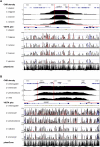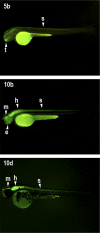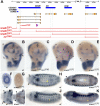An ancient genomic regulatory block conserved across bilaterians and its dismantling in tetrapods by retrogene replacement
- PMID: 22234889
- PMCID: PMC3317147
- DOI: 10.1101/gr.132233.111
An ancient genomic regulatory block conserved across bilaterians and its dismantling in tetrapods by retrogene replacement
Abstract
Developmental genes are regulated by complex, distantly located cis-regulatory modules (CRMs), often forming genomic regulatory blocks (GRBs) that are conserved among vertebrates and among insects. We have investigated GRBs associated with Iroquois homeobox genes in 39 metazoans. Despite 600 million years of independent evolution, Iroquois genes are linked to ankyrin-repeat-containing Sowah genes in nearly all studied bilaterians. We show that Iroquois-specific CRMs populate the Sowah locus, suggesting that regulatory constraints underlie the maintenance of the Iroquois-Sowah syntenic block. Surprisingly, tetrapod Sowah orthologs are intronless and not associated with Iroquois; however, teleost and elephant shark data demonstrate that this is a derived feature, and that many Iroquois-CRMs were ancestrally located within Sowah introns. Retroposition, gene, and genome duplication have allowed selective elimination of Sowah exons from the Iroquois regulatory landscape while keeping associated CRMs, resulting in large associated gene deserts. These results highlight the importance of CRMs in imposing constraints to genome architecture, even across large phylogenetic distances, and of gene duplication-mediated genetic redundancy to disentangle these constraints, increasing genomic plasticity.
Figures








Similar articles
-
Heterogeneous conservation of Dlx paralog co-expression in jawed vertebrates.PLoS One. 2013 Jun 28;8(6):e68182. doi: 10.1371/journal.pone.0068182. Print 2013. PLoS One. 2013. PMID: 23840829 Free PMC article.
-
Evolutionary history of the iroquois/Irx genes in metazoans.BMC Evol Biol. 2009 Apr 15;9:74. doi: 10.1186/1471-2148-9-74. BMC Evol Biol. 2009. PMID: 19368711 Free PMC article.
-
The vertebrate makorin ubiquitin ligase gene family has been shaped by large-scale duplication and retroposition from an ancestral gonad-specific, maternal-effect gene.BMC Genomics. 2010 Dec 20;11:721. doi: 10.1186/1471-2164-11-721. BMC Genomics. 2010. PMID: 21172006 Free PMC article.
-
Hox clusters and bilaterian phylogeny.Mol Phylogenet Evol. 2002 Sep;24(3):366-73. doi: 10.1016/s1055-7903(02)00237-3. Mol Phylogenet Evol. 2002. PMID: 12220978 Review.
-
Iroquois genes: genomic organization and function in vertebrate neural development.Curr Opin Genet Dev. 2002 Aug;12(4):403-8. doi: 10.1016/s0959-437x(02)00317-9. Curr Opin Genet Dev. 2002. PMID: 12100884 Review.
Cited by
-
Comparative genomics of the Hedgehog loci in chordates and the origins of Shh regulatory novelties.Sci Rep. 2012;2:433. doi: 10.1038/srep00433. Epub 2012 May 31. Sci Rep. 2012. PMID: 22666536 Free PMC article.
-
Origin of spliceosomal introns and alternative splicing.Cold Spring Harb Perspect Biol. 2014 Jun 2;6(6):a016071. doi: 10.1101/cshperspect.a016071. Cold Spring Harb Perspect Biol. 2014. PMID: 24890509 Free PMC article.
-
Widespread recurrent evolution of genomic features.Genome Biol Evol. 2012;4(4):486-500. doi: 10.1093/gbe/evs022. Epub 2012 Mar 13. Genome Biol Evol. 2012. PMID: 22417916 Free PMC article. Review.
-
Integrated transcriptomic analysis on small yellow follicles reveals that sosondowah ankyrin repeat domain family member A inhibits chicken follicle selection.Anim Biosci. 2021 Aug;34(8):1290-1302. doi: 10.5713/ajas.20.0404. Epub 2020 Oct 13. Anim Biosci. 2021. PMID: 33152230 Free PMC article.
-
Chromatin and epigenetic features of long-range gene regulation.Nucleic Acids Res. 2013 Aug;41(15):7185-99. doi: 10.1093/nar/gkt499. Epub 2013 Jun 13. Nucleic Acids Res. 2013. PMID: 23766291 Free PMC article. Review.
References
-
- Abascal F, Zardoya R, Posada D 2005. ProtTest: selection of best-fit models of protein evolution. Bioinformatics 21: 2104–2105 - PubMed
-
- Becker T, Lenhard B 2007. The random versus fragile breakage models of chromosome evolution: a matter of resolution. Mol Genet Genomics 278: 487–491 - PubMed
-
- Bejerano G, Pheasant M, Makunin I, Stephen S, Kent WJ, Mattick JS, Haussler D 2004. Ultraconserved elements in the human genome. Science 304: 1321–1325 - PubMed
Publication types
MeSH terms
Substances
Associated data
- Actions
- Actions
LinkOut - more resources
Full Text Sources
Molecular Biology Databases
Research Materials
